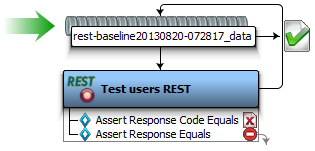

Consolidated REST baseline test cases have a test step that reads from a Large Data data set. The test step is either a REST step or an Execute Transaction Frame step.
The following graphic shows an example of a consolidated REST baseline test case. The test case has a REST step.

If the test case has a REST step, the data set contains such information as the URL, request body, expected response, and response code.
If the test case has an Execute Transaction Frame step, the data set contains the agent name, transaction frame, and expected response.
By default, the data set is local, instead of global.
The test step includes one or more of the following assertions:
Stateful REST baseline test cases have one or more REST steps. Each step includes the Assert Response Code Equals assertion. Each step may include the Assert Response Equals assertion or the Assert Response Value Equals assertion.
The following graphic shows an example of a stateful REST baseline test case.

To run the test case, do one of the following actions:
You can monitor the results in the Consolidated Baseline tab.
Note: For information about how to stage a quick test or a test case, see Running Test Cases and Suites in Using CA Application Test.
|
Copyright © 2014 CA Technologies.
All rights reserved.
|
|